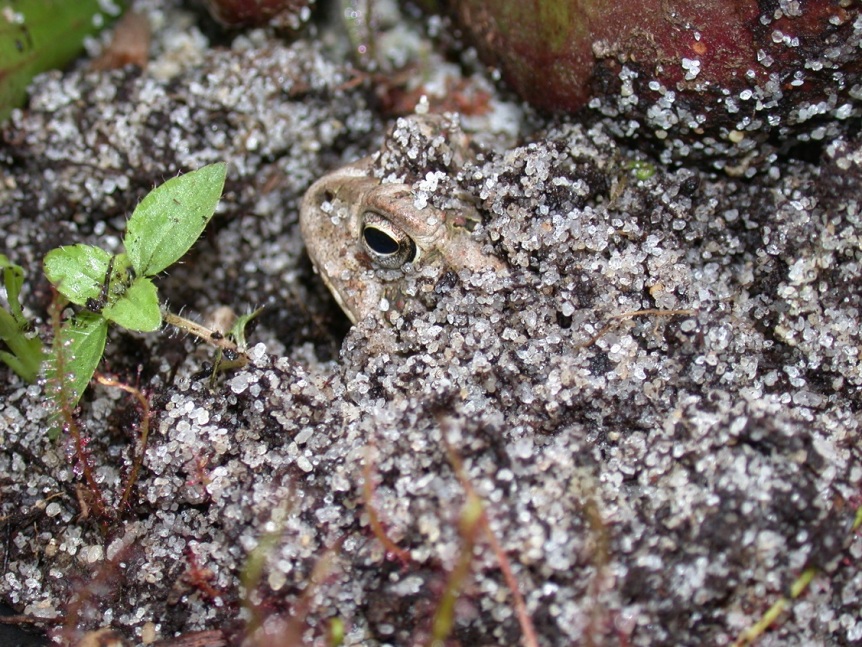I saw the first toad of the year last week, so this seems like a good time for a post about these garden residents who are some of my favorite amphibians. In addition to the true toads, we also have a couple of “toads”–species that are not in the toad family, Bufonidae, but share the common name because of their terrestrial habits.
1. American toads and/or Fowler’s toads

In the NC piedmont, the true toads are represented by the American toad (Anaxyrus americanus, formerly Bufo americanus) and Fowler’s toad (Anaxyrus fowleri, formerly Bufo fowleri). I’m not entirely sure which species we have in the garden. Fowler’s toads are here, but I wouldn’t be surprised if American toads are too. I haven’t paid enough attention to be certain. Although they are the most common amphibians in my garden, I find that I don’t have many photographs of them. Familiarity doesn’t breed contempt, exactly; I love having them around and think they have much more character than their froggy cousins, but I don’t go rushing off for a camera whenever I find one hopping across the garden path.

True toads exude bufotoxins, a witches’ brew of chemicals, including cardiac glycosides and neurotransmitter analogs, from their skin and especially from the bean-shaped parotid glands behind their eyes. When I was a teenager, we had a dog who loved to lick toads. They always made her wrinkle her lips and foam at the mouth, but she never learned to avoid them. I’m not sure if she was getting a buzz off the bufotoxin, or if she lived in eternal hope that the next toad would be the one that tasted good. In any case, it’s probably a good idea to wash your hands after you pick up a toad.
Around the same time that we had the toad-licking dog, I kept a recently metamorphosed toadlet as a pet for a summer. It soon became quite tame and would get very excited whenever I opened the top of the terrarium. The way to a toad’s heart is definitely through its stomach. If you have never fed a toad, do yourself a favor and give the next one you find a large earthworm. The way a toad uses its hands to shovel the wriggly spaghetti into its mouth is both fascinating and hilarious.
2. Eastern spadefoot

The eastern spadefoot (Scaphiopus holbrookii) is a beautiful little amphibian, and I was thrilled to discover that they live in my garden. It’s rather surprising that they are here. S. holbrookii is primarily a species of the sandy coastal plain, and we’re at the very edge of its recorded range. Their presence in the garden might even be a minor range extension, as the NC Museum of Natural Sciences doesn’t seem to have any specimens collected in Orange County. But despite our dense piedmont clay not being their preferred habitat, I stumble across a spadefoot every year or two, suggesting that there is a small breeding population in the vicinity. About half of them have been accidentally unearthed while I was gardening, and the other half were hopping around on the surface, usually at night or early in the morning during warm, wet weather.

Spadefoots can be distinguished at a glance from true toads by their vertical pupils; other toads have horizontal pupils. If you gently pick one up and turn it over, you will see the hard, brownish spades on its hind feet which allow it to burrow out of sight.
3. Eastern narrowmouth toad

Like the eastern spadefoot, the eastern narrowmouth toad (Gastrophryne carolinensis) is another species that you are much more likely to hear than see. If you have ever heard the desperate bleating of a tormented lamb emanating from the leaf litter after rain, you have heard an eastern narrowmouth toad. They seem to be even less likely than the spadefoots to wander around on the surface, and in twenty years I have only found three. Two of them I accidentally uncovered, but the one photographed here came to my attention because it was out during the day and had been found by a chipmunk. I noticed the chipmunk repeatedly run up to a small object and then dance backwards when it hopped. I’m not sure if the chipmunk was attacking (they sometimes prey on insects and other small animals) or playing, but when I rescued the narrowmouth toad, it didn’t seem to have suffered any damage. Perhaps it was protected by its noxious skin secretions, just like a true toad.


That Eastern spadefoot toad looks hecka angry! I wold not get close enough to it to give it an earthworm!
LikeLiked by 1 person
“Though she be but little, she is fierce.”
That spadefoot was probably smaller than your thumb. 😀
LikeLiked by 1 person
I still would not mess with it!
LikeLike
I enjoyed this post so much! What does a toad look like when it is excited?
LikeLiked by 1 person
As I recall, it would hop around and watch my every move, ready to snatch whatever morsel I dropped into the terrarium. That doesn’t sound like much, but this is an animal that spent most of its time imitating a grayish pebble half buried in the dirt.
LikeLiked by 2 people
Great photo of the eastern spadefoot! (They are all good of course, but I really like that one)
LikeLiked by 1 person
Fascinating! So funny about the dog thinking the next toad would taste good. The lizards have reappeared in our garden, but they don’t seem to be going through an indolent phase – they are already too speedy to photograph. I think the only way would be to install a webcam. Or maybe hire a lizard whisperer?
LikeLiked by 1 person
So funny, and great pics! Sounds like gardening and toadwatching go well together. Amazed there are so many species in your garden, must be great habitat.
LikeLike